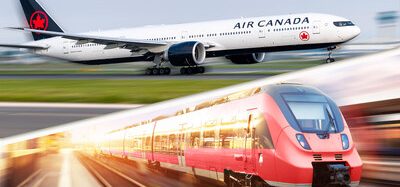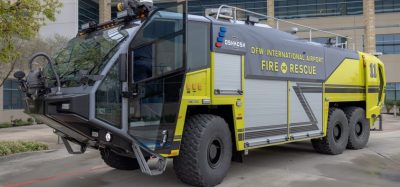Creating tailored experiences within the airport
- Like
- Digg
- Del
- Tumblr
- VKontakte
- Buffer
- Love This
- Odnoklassniki
- Meneame
- Blogger
- Amazon
- Yahoo Mail
- Gmail
- AOL
- Newsvine
- HackerNews
- Evernote
- MySpace
- Mail.ru
- Viadeo
- Line
- Comments
- Yummly
- SMS
- Viber
- Telegram
- Subscribe
- Skype
- Facebook Messenger
- Kakao
- LiveJournal
- Yammer
- Edgar
- Fintel
- Mix
- Instapaper
- Copy Link
Posted: 23 August 2024 | | No comments yet
International Airport Review hosted a webinar on leveraging data and technology in order to create a modern personalised airport experience for passengers. In this article, the speakers dive into some of the fantastic questions asked by the live audience.


On 25 July 2024, International Airport Review hosted a webinar on ‘Creating tailored experiences within the airport’, featuring speakers from Aena, Athens, Warsaw Modlin and Sydney Airports. The presenters were inundated with questions from the live audience, so two of the speakers have taken the time to provide their answers retrospectively.
Catch up on this popular webinar here.
Q: How do you commercialise/advertise your airside/landside products/services as part of the passenger pre-flight digital journey?


C: Athens
Ioanna Papadopoulou, Athens: As Athens Airport’s official parking faces intense competition, with more than 15 different parking lots located in the vicinity, a comprehensive multi-channel strategy has been implemented to advertise our service offering.
More specifically, our strategy includes utilisation of digital media such as Google AdWords (search), Performance Max (PMax), Meta and LinkedIn, with conversion campaigns continuously active 24/7 throughout the year. This ensures that our service remains consistently visible to potential customers, maximising opportunities for engagement and booking at all times.
It also involves direct marketing through newsletters to our customer base, featuring all offers and promotions available on our official website.
Parallel to digital media, offline media is also significant, incorporating on-site out-of-home (OOH) advertising as well as printed ADs in various targeted publications and magazines to reach potential customers.
On top of that, the official airport parking leverages synergies with the international and Greek concepts and stores of Airport Agora for cross-promotion campaigns and exclusive offers to enhance the overall experience for travellers.
This integrated approach ensures that Athens International Airport effectively engages passengers throughout their pre-flight digital journey, keeping the airport’s parking services top of mind in a competitive landscape.
As far as the retail and food and beverage (F&B) offering is concerned, there is an ‘umbrella campaign’ using the Euphoria concept (Euphoria taste, shopping Euphoria, etc.) and our respective advertising/commercial strategy includes utilisation of all the above digital media/channels of communication.
Additionally, as of the beginning of the year, a strategic co-operation, among a selected airline, the airport and selected airport’s outlets, has been activated under the Euphoria campaign. During the first part of the year, Emirates, the Duty Free Shops and the airport have been using their channels of digital communication in a joint promotion under the slogan ‘Feel the Shopping Euphoria’, including the organisation of contests, lotteries etc., aiming both at the passenger pre-flight digital journey as well as at the in-situ (at the airport) interaction with the passenger. Presently, Turkish Airlines is in a strategic co-operation with selected F&B outlets at the airport and the airport itself under the slogan ‘Taste Euphoria’, also using all digital means of communication for the advertising/promotion of the respective F&B outlets.


C: Aena.
Roberto Martín Davara, Aena: The digital journey is crucial, particularly for passengers seeking a 100% seamless travel experience. Through our website or app, you can not only explore various products and services, but also book them. This includes services like ‘Food To Fly’, ‘Shop To Fly’, VIP Lounges and parking, all easily bookable from your phone. Personalisation is also a key aspect of the digital journey, offering tailored products to meet individual needs.
Q: Do you have any experience/insight on how services/products bundling can improve travel experience as well as increase commercial return for your airport?
Roberto Martín Davara, Aena: We find that passengers are happier when airports feel like an extension of their daily lives, whether they wish to work, shop or simply rest before their flight. By addressing everyone’s expectations and allowing passengers to shape their own experience, we ensure they enjoy their time at the airport. Therefore, investing in passenger experience is directly investing in commercial returns.
Q: Who is your self-bag drop kiosk supplier?
Ioanna Papadopoulou, Athens: MATERNA is the supplier. AIA is the owner of the facility. Currently they operate 10 retrofit devices, with no biometric technology. All devices are dedicated to Aegean Airlines, the Greek home-based carrier that accounts for almost 46% market share in ATH.
Q: For Athens, are info pads a locally developed app or part of an AMS system?
Ioanna Papadopoulou: Info-pads are locally developed.
Q: How can more tailored experiences create more revenue for the airport? Or is it more seen as a cost to match up advances in technology in society?
Ioanna Papadopoulou, Athens: By ‘responding’ to the needs and wants of different types of passengers through the commercial offering (products and services) at the airport. The identification of the differentiating characteristics among different types of passengers through market surveys and passenger segmentation, i.e. what the different types of passengers might need, want or prefer during their airport journey, leads to the commercial optimisation (development/introduction of services and products) that reflect these needs and preferences. This in turn leads to increased volume of sales and increased revenues for the airport. In our case, the ’Best of Greece’ concept, i.e. the shaping of our commercial offering towards introducing well-known Greek brands and products, was the outcome of market surveys pointing to this direction and it was very well received by the travelling public.
Obviously, another very important aspect of creating tailor-made experiences aims at catering for the needs of specific categories of passengers and it resonates extremely well with our airport’s strategic goal of addressing accessibility issues and being a ‘responsible citizen’. For instance, the development of an app especially for the communication support of deaf and hard-of-hearing travellers falls under this category.
Q: How do you get to start conversations with start-ups? Is there a person of reference?
Ioanna Papadopoulou: At Athens International Airport, mainly through ‘The Digital Gate’, the acceleration and innovation programme that we are organising in co-operation with the support of the Entrepreneurship Center and Innovation (ACEin) of the Athens University of Economics and Business.
The aim of the programme is the co-creation and implementation of business proposals that solve significant challenges in the field of transport and tourism. The programme is looking for talented people who, with the participation of experienced airport staff, will propose innovative, technological solutions that are implemented, initially as pilot projects, at the airport environment.
For more info: https://thedigitalgate.gr/en/current-pocs-en/
Roberto Martín Davara, Aena: We have a start-up acceleration programme called Aena Ventures. The winning start-ups have the possibility to participate in a pilot project with Aena, receive mentoring during the process, and potentially have a direct contract of up to €2 million to deploy their solutions.
In the latest edition, we received 514 proposals from 40 countries. Aena Ventures selected five technological startups in the growth phase to add value to Aena and develop pilot projects in a real airport environment, supported by our internal teams.
Q: I have a question about the security family lane in Spain: did it also lead to a higher throughput at other lanes because all families are separate? Or is it only a service with satisfaction impact for families?
Roberto Martín Davara, Aena: Family lanes at security provide a dual benefit. They allow families, who typically need more time and extra trays, to move at their own pace in a more relaxed environment suited for younger travellers. This also benefits other passengers by enabling a quicker passage through standard security lanes.
Q: How do you reduce the stress of the passengers into getting to their destinations, do the airports guide them until they arrive at the city?
Ioanna Papadopoulou: First of all, through our market surveys and other tools, we measure and monitor stress levels through the different touch points, so we identify the pain points and the areas where there is a need for corrective actions.
Our efforts towards reducing our passengers’ stress levels include mobile agents in different touch points (human presence has proven to be the most efficient when it comes to the alleviation of stress and complicated situations requiring immediate solutions) and information/links through digital channels and QR-codes, so that the travellers can download all the necessary and accurate information.
An interesting case is that of the Chinese travellers; acknowledging the fact that a large percentage of these travellers might experience a language barrier, two ‘Chinese-speaking’ robots are soon to be re-introduced upon the arrival of the Chinese carriers in order to welcome and provide all necessary information to Chinese passengers in their language.
Roberto Martín Davara, Aena: Stress is a primary driver of passenger dissatisfaction. To address this, we collaborate with all stakeholders to minimise stress, particularly at touchpoints frequently perceived as stressful. Passengers expect fast and clear information about reaching their destinations, regardless of the channel they use.
To meet this expectation, we periodically review our wayfinding systems, both onsite and digital. For example, passengers can easily ask our chatbot via WhatsApp for guidance, utilising our own wayfinding system, Aena Maps. This system is accessible to everyone and adapts to specific needs, including those of PRM passengers.
Q: In terms of utilising data, how does the airport manage personalised passenger experiences while the airlines have the passenger data?
Ioanna Papadopoulou: By capturing what we call the voice of passengers in three different business axes: route development, commercial optimisation and passenger experience. The data acquired through various tools and sources of information, such as survey projects, audit mechanisms, passenger and social media comments, PrivateReview, smiley faces, Google analytics and other tailor-made, customised tools, are utilised in order to enhance and optimise the passenger experience at the different touchpoints of the passenger’s journey.
By mapping passenger behavioural profiles across the end-to-end journey, informed decisions can be made, opportunities and pain points are identified for all customer types, thus offering a better understanding on the design and enhancement of tailor-made passenger experiences.
Roberto Martín Davara, Aena: We maintain a continuous dialogue with our passengers through a variety of channels. These include traditional surveys, instant feedback mechanisms, PRM services surveys, commercial insights, our app, social media platforms and complaints, among many others. Additionally, we collaborate closely with airlines to ensure that we are consistently delivering the best possible experience.
Q: What’s the average budget spent by year to get the VOC (voice of the customer/pax)?
Ioanna Papadopoulou, Athens: An airport’s marketing approach lies on its investment in studying hard facts, while in parallel listening to passengers through the continuous investigation of their needs and drivers, via market research. ΑΙΑ invests heavily in ‘Listening to Customers’, though various tools and sources of information: survey projects, audit mechanisms, passenger and social media comments, PrivateReview, smiley faces, Google Analytics, providing insights to four main areas: customer experience, passenger satisfaction, routes and tourism development, commercial optimisation & development, corporate branding development.
Focusing on service excellence, market intelligence feedback derives from either direct contact with our passengers (passenger and social media comments), or other monitoring tools.
Our strategic goal being not only to maintain, but also to continuously improve the high level of services, we have developed two additional innovative tools to monitor and safeguard passenger satisfaction:
i-mind: the programme engages all AIA staff, regardless of level or operational expertise, in carrying out various walk-throughs at the airport premises in order to evaluate the passenger experience, in real time. The programme commenced in February 2024 and to date, AIA employees managed to implement more than 1,400 walkthroughs, equivalent to more than 120,000 checks in specific areas of the passenger journey, highlighting critical pain points. Moreover, 67 alerts were emitted, calling for and achieving also the rapid resolution of terminal infrastructure issues.
i-mind offers to AIA participants the opportunity to collect miles, based on the number of visits and overall effort required, this offer being complemented with substantial prizes and awards. The latest statistics include 520 standard i-minders, 23 engaged i-minders, 61 i-mind lovers and 117 i-mind freaks, indicating that more than 60% of AIA employees have already been personally involved in shaping ATH airport passenger experience.
AI passenger emotional engagement: the measurement of subconscious drivers of passenger experience, derived from passenger comments, Chatbot, social media, airport’s call centre, using AI technology (an AI-generated real-time dashboard) for analysis and passenger segmentation.
Emotional engagement metrics through the use of AI, seem to be the next generation of passenger experience measurements, going deeper than traditional passenger satisfaction metrics and developing personalised service delivery protocols. To be specific, passenger segmentation of the dynamic Athens-American market has been conducted as of last year, leading to the customisation of services/products for this demanding group of passengers.
Athens International Airport’s average annual budget spent to get VOC amounts to approximately €500,000.
Q: How does technology like common use self-service (CUSS) checking kiosks solution help to improve PAX journey and improve pax processing? What is the percentage of passengers using those solutions including self-bag drop and CUSS?
Ioanna Papadopoulou, Athens: As far as the improvement of passenger journey and passenger processing: CUSS solution is available on a 24/7 basis, reducing waiting times and contributing to increased convenience during peak times; passengers can select their seats, add additional services, and customise their travel experience directly through the kiosk interface, a function which is considered to substantially improve passengers’ overall satisfaction. Additionally, through CUSS, the check-in processes are streamlined, resulting in operational and efficiency gains, i.e. alleviating the workload pressure on airline staff, minimising the need for numerous check-in counters and staff, thus resulting in efficiency gains for the airlines and the airport.
Currently 16 out of 66 airlines are connected on CUSS.
The percentage of departing passengers using self-baggage drop off amounts to 20-25% depending on the availability of the devices and the operational needs.
Watch the webinar on-demand at your convenience.
About the authors
Ioanna Papadopoulou, Director of Communications and Marketing, Athens International Airport
Ioanna started her career with the Hellenic Civil Aviation Authority. In 2001, she joined the Ministry of Transport and Communications as an advisor on Civil Aviation issues, and she held the position of the CEO of Olympic Airways-Services SA from December 2003 to May 2006. Between May 2006 and September 2009, Ioanna worked for the Hellenic Civil Aviation Authority as the Chief Negotiator/Senior Expert on Bilateral Air Services Agreements and International Relations. As of October 2009, Ioanna is the Director, Communications & Marketing at Athens International Airport. She was also presented with the ‘Woman of the Year’ award by the Air Transport News in 2014.
Roberto Martín Davara, Head of Facilitation & Passenger Experience Dept. at Aena
Roberto is responsible for the passenger experience within the Aena network, including 46 airports and 2 heliports in Spain. Applying a holistic data-driven approach, he and his team work towards setting new standards in the airport experience. He is a member of the ACI World’s ASQ Subcommittee and the ACI Europe’s Facilitation and Customer Services Committee. Roberto holds a degree in Aeronautical Engineering (MSc) and loves traveling the world.
Related topics
Artificial intelligence (AI), Big data, Data, Digital transformation, Food and Beverage (F&B), New technologies, Passenger experience and seamless travel, Security, Self-service, Terminal operations, Tourism, Workforce
Related airports
Athens International Airport (ATH), Sydney Airport (SYD), Warsaw Modlin Airport (WMI)


















